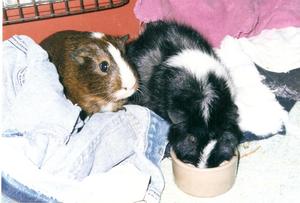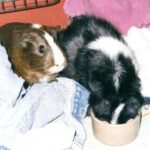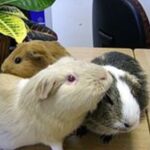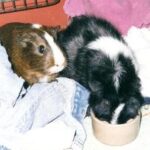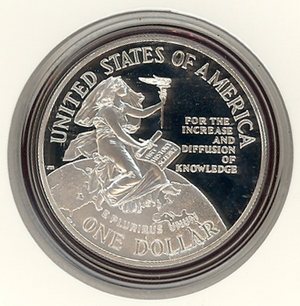Cavies or guinea pigs have been domesticated for thousands of years. It is known that the ancient Incas developed different strains relating to hair length and how well they tasted. Today’s guinea pigs contain a wide variety of genetic mutations relating to color hair and even size, leading to the creation of a multitude of breeds. These breeds are usually identified by their hair type and sometimes their color.
One note here – some guinea pig show breeders will claim that guinea pigs of a certain color are in a certain breed. Usually, guinea pigs of one color – even if they are bred to a mate of identical coloration – will produce different colored babies. So, even though colors referred to as breeds can be a bit confusing, just when in Rome do what the Romans do.
Smoothies, Shorthairs, English or American
These are your basic guinea pig. As you can see, they are known as a wide variety of names. The guinea pig Rodney in the Eddie Murphy movie Dr. Doolittle (1989) is an example of one of these kinds of guinea pigs. They are easy to groom, come in a virtual piggy rainbow of colors and can become very affectionate with patience.
There is a very shiny version considered its own separate breed called a Satin. There is also a separate breed that has one conspicuous whorl on the top of the head, known as a Self Crested (the same color as the rest of the guinea pig’s body) and White Crested (the white has to contrast with the head color).
Abyssinian
These guinea pigs have rough coats that are often decorated with whorls or rosettes. The guinea pig featured in the popular children’s series, Olga da Polga, was an Abyssinian. There are many who claim that Abyssinians are the most intelligent of guinea pig breeds, but there is no way to prove this. It is unknown how they got the name Abyssinian, since they were originally bred in South America. Abyssinians also have a Satin variety.
Peruvian and Coronet
These are very long-haired guinea pigs that mostly resemble a Tribble from Star Trek. Many owners of pet Peruvians keep their pet’s coats trimmed, because the hair is a nightmare to take care of. Recommended only for people with a lot of patience and guinea pig experience.
The Coronet is a variation of the Peruvian where the long coat does grow all over the face. What’s on the top of the head is usually a whorl similar to a Self or White Crested.
Teddy or Rex
This breed has a very fuzzy, wiry coat with a much blunter nose shape than other breeds. It’s is also known under a variety of names. There is a teddy version of the Peruvian called a Texel. In attitude and intelligence, they are just like any other guinea pig. There is also a Satin variety.
Hairless
A hairless “Skinny Pig” variety was developed for medical testing, as well as a mostly hairless breed called a Baldwin. It was easier to see the results of skin care experiments on a hairless creature than one fully-furred. In time, these bizarre creatures made it to the pet trade. They need special care, as they are susceptible to sunburn, chills and injuries. Hairless or mostly hairless guinea pigs are not recommended for beginners because of the difficulty in caring for them.
Super Pig
This is a much bigger type of short haired guinea pig bred purposefully for meat in South America and for South American populations in the rest of the world. They are nearly twice as heavy as the ordinary pet guinea pig. They are not popular in the pet trade because of their size.
Additional References
“What’s My Guinea Pig? A Guide to Guinea Pig Breeds.” Peter Gurney. TFH Publications; 1997.
“Guinea Pigs.” Audrey Pavia, et al. Bow Tie Press; 2005.
Rare Varieties Guinea Pig Club. “Guide Standard Breed.”
http://www.rvcc.co.uk/Rare_Varieties_Cavy_Club/Guide_Standard_Breeds.html
